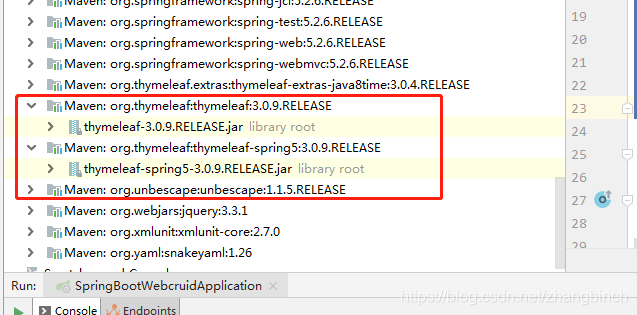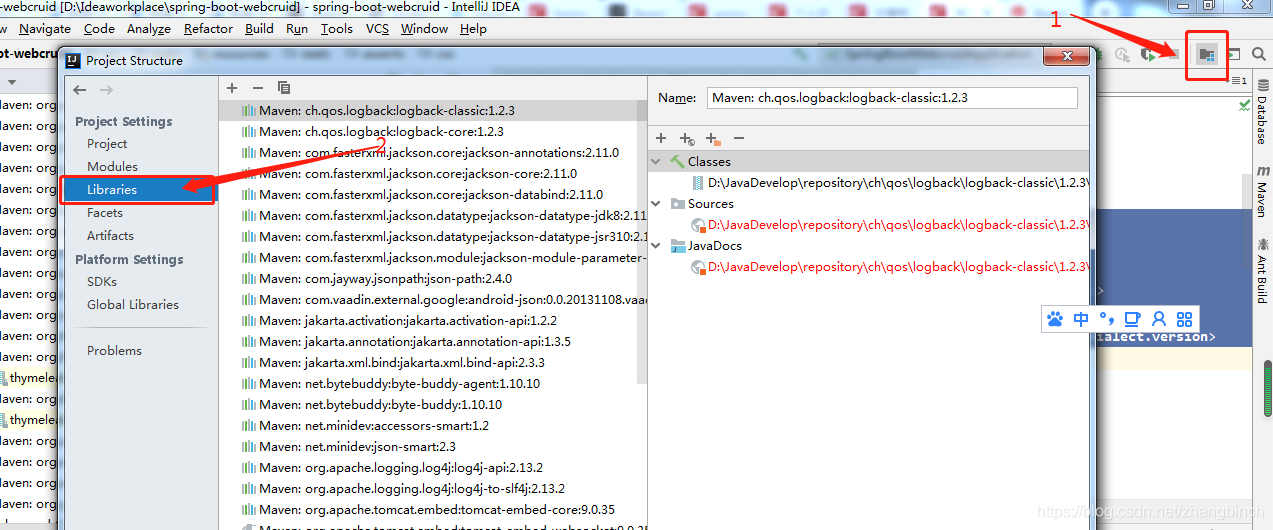在做springcloud项目时,出现了如下报错:
关键异常信息为:
1.简单看一下报错信息,找不到依赖,或者可以理解为依赖失败,看一下截取的部分报错信息
org.springframework.beans.factory.UnsatisfiedDependencyException:
Error creating bean with name 'goshowController':
针对这个报错,网上找到了很多关于它可能的解决方案
(1) 启动类没有创建(项目都启动了,没启动类,或者启动类注解引入错误,这个一般不会是此情况,除非自己手敲启动类):
有人遇到的是这样的:测试包下的启动类不能和main的启动类 不能同名,所导致的问题;
(2) 没有在配置文件中,配置启动自动扫描Service所在的包:截取网上的两端配置信息演示:
<context:component-scan base-package="com.liglei.service"></context:component-scan>
<!-- 启动自动扫描 -->
<context:component-scan base-package="com.ssm.blog.*">
<!-- 制定扫包规则 ,不扫描@Controller注解的JAVA类 -->
<context:exclude-filter type="annotation" expression="org.springframework.stereotype.Controller"/>
</context:component-scan>
(3) service接口实现类上有没有加@Service注解,注解是不是引用的spring的类?不要导错包:
或者干脆,接口有没有写实现类,实现类是实现的对应接口么?比如CategoryServiceImpl implementsCategoryDAO 一不小心根据自动提示,本来应该实现CategoryService,结果实现了CategoryDAO
(4) 查看注入是否正确:比如有网友遇到:
在mapper中使用的@Mapper注解的时候
导了错误的包
import org.mapstruct.Mapper;
应该导入
import org.apache.ibatis.annotations.Mapper;
(5) 看看jar包是否下载完整,是否有这个jar包,或者依赖冲突:
比如,加了thymeleaf的jar,加入的配置如下
<properties>
<thymeleaf.version>3.0.9.RELEASE</thymeleaf.version>
<!-- 布局功能的支持程序 thymeleaf3主程序 layout2以上版本 -->
<!-- thymeleaf2 layout1-->
<thymeleaf-layout-dialect.version>2.2.2</thymeleaf-layout-dialect.version>
</properties>
<dependency>
<groupId>org.springframework.boot</groupId>
<artifactId>spring-boot-starter-thymeleaf</artifactId>
</dependency>
加入配置后,我检查我们maven的jar,问题就出来了,我们springboot自己下载的版本是3.0.9,然后我再指定一个3.0.9,就导致报错了,我们只需要删掉一个即可解决此问题

去除方法如下图

或者,看看下图红色方框内是否有包没导进去,有就按照下面的步骤完成:
File–>Project Structure–>Artifacts–>右键demoPage–>Put into Output Root–>OK

确保以上步骤没问题的,重启一下项目试试~
------------------------------------------------------------------------------------------
但我遇到的问题,都不是以上情况:我的还有如下报错信息:
2.
nested exception is java.lang.IllegalStateException:
Method has too many Body parameters:
org.springframework.beans.factory.UnsatisfiedDependencyException: Error creating bean with name 'goshowController': Unsatisfied dependency expressed through field 'goshowService'; nested exception is org.springframework.beans.factory.BeanCreationException: Error creating bean with name 'com.csair.lds.shell.openfeign.GoshowService': FactoryBean threw exception on object creation; nested exception is java.lang.IllegalStateException: Method has too many Body parameters: public abstract com.csair.lds.model.result.Results com.csair.lds.shell.openfeign.GoshowService.addGoshowPsg(com.csair.lds.shell.dto.PaxInfo,com.csair.lds.shell.dto.FlightInfo)
网上给出如下解释:
feign中,如果发送的是get请求去调用其它模块的方法,在接口处,形参需要添加 @RequestParam 注解。
org.springframework.beans.factory.UnsatisfiedDependencyException: Error creating bean with name 'dispathcherController': Unsatisfied dependency expressed through field 'userServiceFeign'; nested exception is org.springframework.beans.factory.BeanCreationException: Error creating bean with name 'com.offcn.webui.service.UserServiceFeign': FactoryBean threw exception on object creation; nested exception is java.lang.IllegalStateException: Method has too many Body parameters: public abstract com.offcn.common.response.AppResponse com.offcn.webui.service.UserServiceFeign.login(java.lang.String,java.lang.String)
会先报创建bean异常
org.springframework.beans.factory.UnsatisfiedDependencyException
再报
java.lang.IllegalStateException
其内容为:Method has too many Body parameters
将方法上添加注解 @RequestParam 后正常
//调用user模块的方法 @GetMapping("/user/login") public AppResponse<UserRespVo> login(@RequestParam String username,@RequestParam String password);
原因为spring底层校验导致的。

那么,很明显,我的报错信息如出一辙,我需要传入的参数为两个对象信息,但使用openFeign接口,有如下两个注解@ResquestParam和@RequestBody:
openFeign接口方法传递多个参数时错误:nested exception is java.lang.IllegalStateException: Method has too many Body parameters: public abstract xxx
这是因为feign客户端的方法参数没有用相关的注解
@RequestParam
1. 客户端@RequestParam注解的value属性必须指定值,要和服务端接口参数名保持一致
2. 如果需要传递多个字符串参数,要使用多个@RequestParam注解与服务端接口参数保持对应
@RequestBody
1. @RequestBody 注解在服务端和客户端都需要使用
2. 参数名和参数类型在服务端和客户端需要保持一致
3. 一般用于传递对象
例:
远程Controller
@RestController @RequestMapping("/storage") public class StorageController { @Autowired private StorageService storageService; @RequestMapping("/decrease") public CommonResult decrease(Long productId,Integer count){ storageService.decrease(productId,count); return new CommonResult(200,"扣减库存成功"); } }
FeignClient
@FeignClient("seata-storage")
@Component
public interface StorageService {
@PostMapping("/storage/decrease")
CommonResult decrease(@RequestParam(value = "productId") Long productId,
@RequestParam(value = "count") Integer count);
}
注:
openFeign默认使用@RequestBody,但只允许一个@RequestBody,所以:
1. 只传递一个参数无需注解
2. 传递多个参数时要用@RequestParam
若远程Controlle方法参数有@PathVariable注解,则FeignClient传递参数也必须用@PathVariable注解,且指定@PathVariable的value对应Controller。
很明显,这两个注解都不能满足我在项目中的要求,那么,我又开始搜索,feign如何传递两个对象参数。
Springcloud-feign:
在微服务盛行的时代,我们必不可少的使用到远程调用,可远程调用的组件和框架有很多,restTemplate和feign就是其中很经典的使用组件,由于feign通常会配合spring cloud使用,而restTemplate因其api复杂,分布式场景支持有限,feign必将会是远程调用的首选。在进行springboot拆分成springcloud项目的时候,我使用feign来进行微服务的调用
了解Feign历史的朋友会知道,Feign本身是Netflix的产品,Spring Cloud Feign是在原生Feign的基础上进行了封装,引入了大量的SpringMVC注解支持,这一方面使得其更容易被广大的Spring使用者开箱即用,但也产生了不小的混淆作用。所以在使用Spring Cloud Feign之前,笔者先介绍一下SpringMVC的一个入参机制。预设一个RestController,在本地的8080端口启动一个应用,用于接收http请求
SpringMVC的请求参数绑定机制:
@RestController public class BookController { @RequestMapping(value = "/hello") // <1> public String hello(String name) { // <2> return "hello " + name; } }
这个接口写起来非常简单,但实际springmvc做了非常多的兼容,使得这个接口可以接受多种请求方式。
-
RequestMapping代表映射的路径,使用GET,POST,PUT,DELETE方式都可以映射到该端点。
-
SpringMVC中常用的请求参数注解有(@RequestParam,@RequestBody,@PathVariable)等。name被默认当做@RequestParam。形参String name由框架使用字节码技术获取name这个名称,自动检测请求参数中key值为name的参数,也可以使用@RequestParam(“name”)覆盖变量本身的名称。当我们在url中携带name参数或者form表单中携带name参数时,会被获取到。
POST /hello HTTP/1.1 Host: localhost:8080 Content-Type: application/x-www-form-urlencoded name=formParam
或者:
GET /hello?name=queryString HTTP/1.1
Host: localhost:8080
Feign的请求参数绑定机制
上述的SpringMVC参数绑定机制,大家应该都是非常熟悉的,但这一切在Feign中有些许的不同。
我们来看一个非常简单的,但是实际上错误的接口写法:
//注意:错误的接口写法 @FeignClient("book") public interface BookApi { @RequestMapping(value = "/hello",method = RequestMethod.GET) String hello(String name); }
配置请求地址:
ribbon: eureka: enabled: false book: ribbon: listOfServers: http://localhost:8080
我们按照写SpringMVC的RestController的习惯写了一个FeignClient,按照我们的一开始的想法,由于指定了请求方式是GET,那么name应该会作为QueryString拼接到Url中吧?发出一个这样的GET请求:
GET /hello?name=xxx HTTP/1.1
Host: localhost:8080
而实际上,RestController并没有接收到,我们在RestController一侧的应用中获得了一些提示:

-
并没有按照期望使用GET方式发送请求,而是POST方式
-
name参数没有被封装,获得了一个null值
查看文档发现,如果不加默认的注解,Feign则会对参数默认加上@RequestBody注解,而RequestBody一定是包含在请求体中的,GET方式无法包含。所以上述两个现象得到了解释。Feign在GET请求包含RequestBody时强制转成了POST请求,而不是报错。
理解清楚了这个机制我们就可以在开发Feign接口避免很多坑。而解决上述这个问题也很简单
-
在Feign接口中为name添加@RequestParam(“name”)注解,name必须指定,Feign的请求参数不会利用SpringMVC字节码的机制自动给定一个默认的名称。
-
由于Feign默认使用@RequestBody,也可以改造RestController,使用@RequestBody接收。但是,请求参数通常是多个,推荐使用上述的@RequestParam,而@RequestBody一般只用于传递对象。
Feign绑定复合参数
指定请求参数的类型与请求方式,上述问题的出现实际上是由于在没有理清楚Feign内部机制的前提下想当然的和SpringMVC进行了类比。同样,在使用对象作为参数时,也需要注意这样的问题。
对于这样的接口
@FeignClient("book")
public interface BookApi {
@RequestMapping(value = "/book",method = RequestMethod.POST)
Book book(@RequestBody Book book); // <1>
@RequestMapping(value = "/book",method = RequestMethod.POST)
Book book(@RequestParam("id") String id,@RequestParam("name") String name); // <2>
@RequestMapping(value = "/book",method = RequestMethod.POST)
Book book(@RequestParam Map map); // <3>
//错误的写法
@RequestMapping(value = "/book",method = RequestMethod.POST)
Book book(@RequestParam Book book); // <4>
}
-
使用@RequestBody传递对象是最常用的方式。
-
如果参数并不是很多,可以平铺开使用@RequestParam
-
使用Map,这也是完全可以的,但不太符合面向对象的思想,不能从代码立刻看出该接口需要什么样的参数。
-
错误的用法,Feign没有提供这样的机制自动转换实体为Map。
Feign中使用@PathVariable与RESTFUL规范
这涉及到一个如何设计RESTFUL接口的话题,我们知道在自从RESTFUL在2000年初被提出来之后,就不乏文章提到资源,契约规范,CRUD对应增删改查操作等等。下面笔者从两个实际的接口来聊聊自己的看法。
根据id查找用户接口:
@FeignClient("user")
public interface UserApi {
@RequestMapping(value = "/user/{userId}",method = RequestMethod.GET)
String findById(@PathVariable("id") String userId);
}
这应该是没有争议的,注意前面强调的,@PathVariable(“id”)括号中的id不可以忘记。那如果是“根据邮箱查找用户呢”?很有可能下意识的写出这样的接口:
@FeignClient("user")
public interface UserApi {
@RequestMapping(value = "/user/{email}",method = RequestMethod.GET)
String findByEmail(@PathVariable("email") String email);
}
首先看看Feign的问题。email中通常包含’.‘这个特殊字符,如果在路径中包含,会出现意想不到的结果。我不想探讨如何去解决它(实际上可以使用{email:.+}的方式),因为我觉得这不符合设计。
再谈谈规范的问题。这两个接口是否是相似的,email是否应该被放到path中?这就要聊到RESTFUL的初衷,为什么userId这个属性被普遍认为适合出现在RESTFUL路径中,因为id本身起到了资源定位的作用,他是资源的标记。而email不同,它可能是唯一的,但更多的,它是资源的属性,所以,笔者认为不应该在路径中出现非定位性的动态参数。而是把email作为@RequestParam参数。
RESUFTL结构化查询
笔者成功的从Feign的话题过度到了RESTFUL接口的设计问题,也导致了本文的篇幅变长了,不过也不打算再开一片文章谈了。
再考虑一个接口设计,查询某一个月某个用户的订单,可能还会携带分页参数,这时候参数变得很多,按照传统的设计,这应该是一个查询操作,也就是与GET请求对应,那是不是意味着应当将这些参数拼接到url后呢?再思考Feign,正如本文的第二段所述,是不支持GET请求携带实体类的,这让我们设计陷入了两难的境地。而实际上参考一些DSL语言的设计如elasticSearch,也是使用POST JSON的方式来进行查询的,所以在实际项目中,笔者并不是特别青睐CRUD与四种请求方式对应的这种所谓的RESTFUL规范,如果说设计RESTFUL应该遵循什么规范,那大概是另一些名词,如契约规范和领域驱动设计。
@FeignClient("order")
public interface BookApi {
@RequestMapping(value = "/order/history",method = RequestMethod.POST)
Page<List<Orders>> queryOrderHistory(@RequestBody QueryVO queryVO);
}
RESTFUL行为限定
在实际接口设计中,我遇到了这样的需求,用户模块的接口需要支持修改用户密码,修改用户邮箱,修改用户姓名,而笔者之前阅读过一篇文章,也是讲舍弃CRUD而是用领域驱动设计来规范RESTFUL接口的定义,与项目中我的想法不谋而合。看似这三个属性是同一个实体类的三个属性,完全可以如下设计:
@FeignClient("user")
public interface UserApi {
@RequestMapping(value = "/user",method = RequestMethod.POST)
User update(@RequestBody User user);
}
但实际上,如果再考虑多一层,就应该产生这样的思考:这三个功能所需要的权限一致吗?真的应该将他们放到一个接口中吗?实际上,笔者并不希望接口调用方传递一个实体,因为这样的行为是不可控的,完全不知道它到底是修改了什么属性,如果真的要限制行为,还需要在User中添加一个操作类型的字段,然后在接口实现方加以校验,这太麻烦了。而实际上,笔者觉得规范的设计应当如下:
@FeignClient("user")
public interface UserApi {
@RequestMapping(value = "/user/{userId}/password/update",method = RequestMethod.POST)
ResultBean<Boolean> updatePassword(@PathVariable("userId) String userId,@RequestParam("password") password);
@RequestMapping(value = "/user/{userId}/email/update",method = RequestMethod.POST)
ResultBean<Boolean> updateEmail(@PathVariable("userId) String userId,@RequestParam("email") String email);
@RequestMapping(value = "/user/{userId}/username/update",method = RequestMethod.POST)
ResultBean<Boolean> updateUsername(@PathVariable("userId) String userId,@RequestParam("username") String username);
}
-
一般意义上RESTFUL接口不应该出现动词,这里的update并不是一个动作,而是标记着操作的类型,因为针对某个属性可能出现的操作类型可能会有很多,所以我习惯加上一个update后缀,明确表达想要进行的操作,而不是仅仅依赖于GET,POST,PUT,DELETE。实际上,修改操作推荐使用的请求方式应当是PUT,这点笔者的理解是,已经使用update标记了行为,实际开发中不习惯使用PUT。
-
password,email,username都是user的属性,而userId是user的识别符号,所以userId以PathVariable的形式出现在url中,而三个属性出现在ReqeustParam中。
顺带谈谈逻辑删除,如果一个需求是删除用户的常用地址,这个api的操作类型,我通常也不会设计为DELETE请求,而是同样使用delete来标记操作行为
@RequestMapping(value = "/user/{userId}/address/{addressId}/delete",method = RequestMethod.POST)
ResultBean<Boolean> updateEmail(@PathVariable("userId") String userId,@PathVariable("userId") String email);
官方对feign有如下说明:https://github.com/OpenFeign/feign
Feign makes writing java http clients easier
Feign is a Java to HTTP client binder inspired by Retrofit, JAXRS-2.0, and WebSocket. Feign's first goal was reducing the complexity of binding Denominator uniformly to HTTP APIs regardless of ReSTfulness.
Feign 是一个声明式 Web服务客户端,使用它创建一个接口并注解,使得编写 Web服务客户端变得更加容易。
它支持可插拔注解,包括 Feign 注解和 JAX-RS 注解,还支持可插拔的编码、解码器。
Cloud 增加了对 Spring MVC 注解的支持,默认使用 httpmessageconverter 的支持。
Cloud 集成了 Ribbon 和 Eureka以及 BalanceLoad,使得在使用 Feign 时支持 Http 客户端的负载均衡。
Feign 自定义的客户端配置不需要使用 @Configuration 配置注解。如果使用了,需要排除在 @ComponentScan 注解扫描之外。否则,它将成为 feign.Encoder、feign.Decoder、feign.Contract等组件的默认实现。如果指定了,可以在 @ComponentScan 中显示排除。
参考文章:
1. https://blog.csdn.net/qq_38152400/article/details/109597676
2. https://blog.csdn.net/pc8650/article/details/108749590
feign的介绍与使用:
1.https://blog.csdn.net/xianghe_qqq/article/details/109693420
2.https://blog.csdn.net/liu_ares/article/details/103599418
3.https://blog.csdn.net/weixin_42794008/article/details/106881431
feign搭建:
1. https://blog.csdn.net/weixin_38312502/article/details/105920219